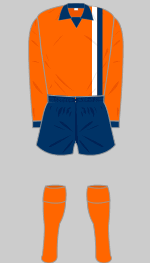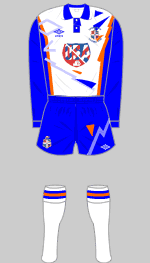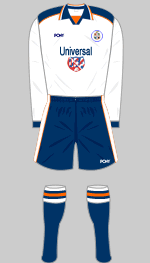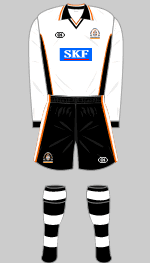


Luton
Town
Formed 1885
Elected to Division Two 1897. Resigned 1900
Founder members of Division Three 1920. Relegated to The Conference 2009.
Promoted to League Two 2014.
Kit History
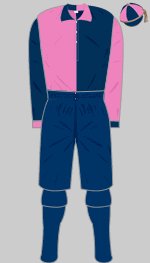
1885-1889 a m x C
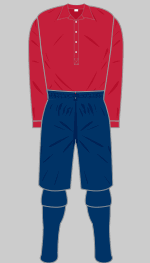
1889-1892 l x
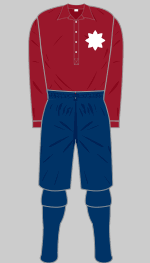
1892-1896 b l m x
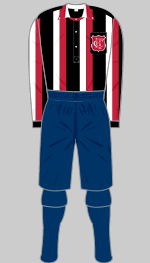
1896-1898 l x
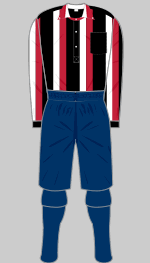
1896-1898 alt l m x
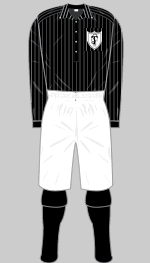
1898-Sept 99 b l w x

Oct 99-1900 x

1900-1906 b l x
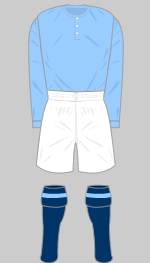
1906-1907 l
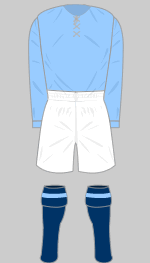
1907-1910 b t l
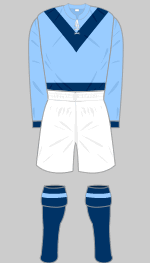
1910-1915 b l
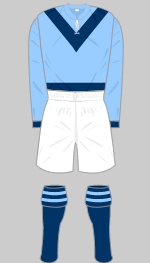
1919-1920 l
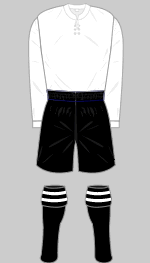
1920-1932 b l
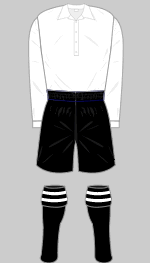
1932-1933 l
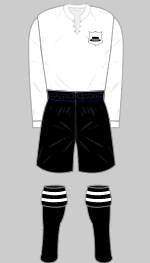
1933-1934 l
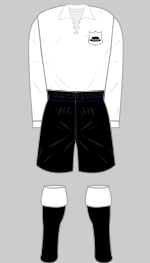
1934-1935 l
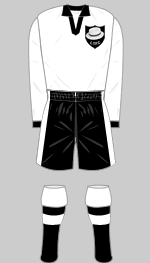
1935-1936 f l t
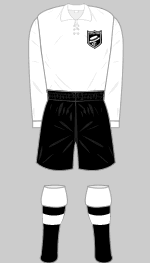
1936-1939 l t
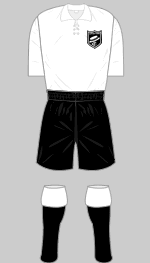
1939-1940 l t
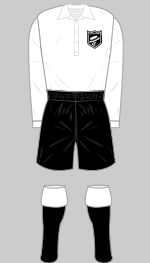
1946-1947 l t
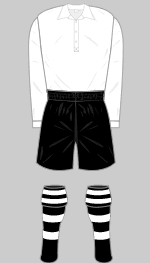
1947-1953 c d f l y
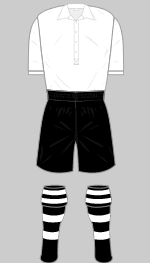
1953-Sept 54 B
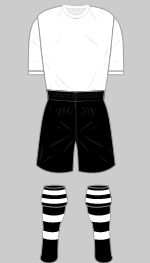
Sept 54-1955 l v y B
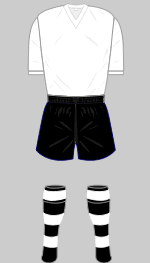
1955-1956 f l

Aug-Dec 1956 l
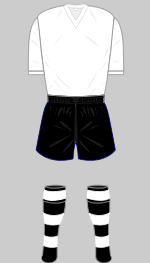
Jan 57-March 58 l
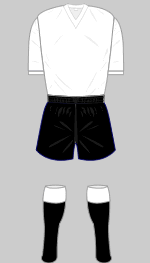
April 1958 l
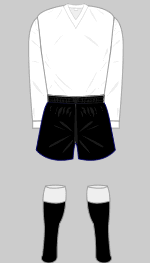
Aug-Dec 1958
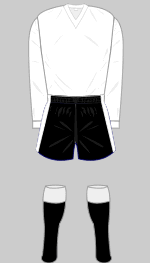
Jan-April 1959 c e f g l

1959-1962 l
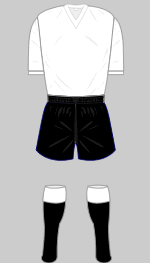
1962-1963 l
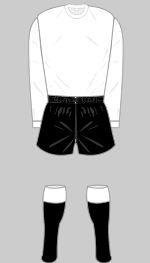
1962-1964 alt l

late 1963-1964 j l
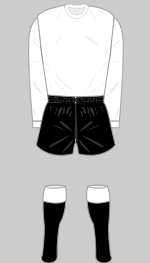
1964-1965 j
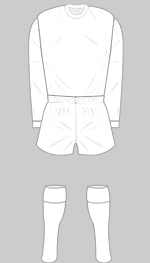
1965-1966 alt l
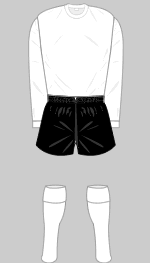
1965-1970 c l
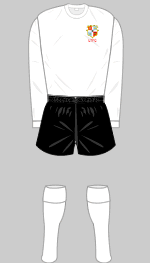
1970-1972 c f h l
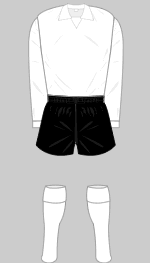
1972-1973 p
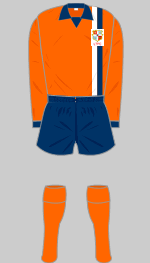
1973-1974 1 A
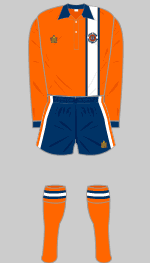
1974-1976 c e l r
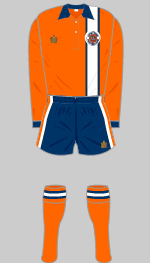
1976-1978 l

1978-1979 l r
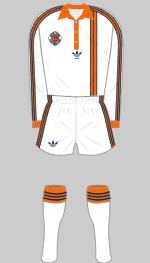
1979-Feb1980 d
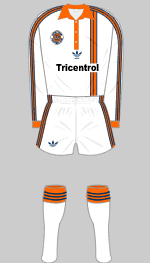
March-April 1980 d j l
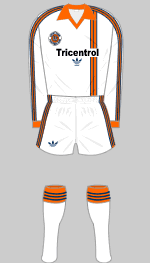
1980-1981 o
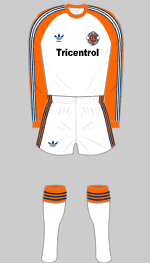
1981-1982 f k l
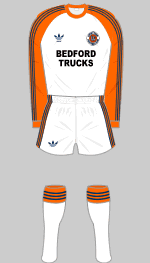
1982-1983 f
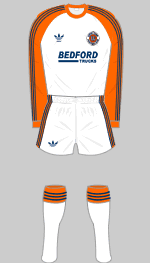
1983-1984 f
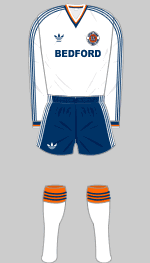
1984-1987 c f

1987-1988 l

1988-Jan 1989 f l t
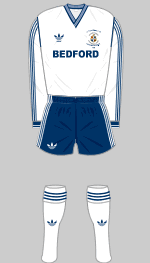
Feb-May 1989 t
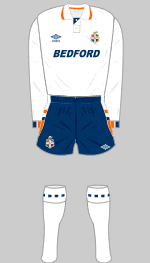
1989-1990 f m
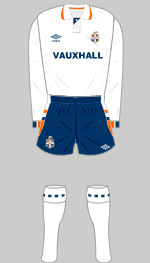
1990-1991 f m
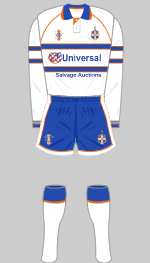
1992-1993 t
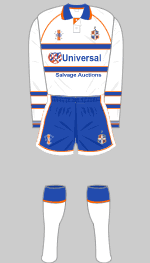
1993-1994 a f m
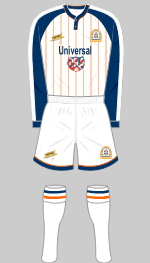
1994-1995 a m o t
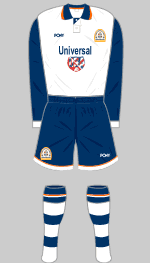
1995-1997 f m
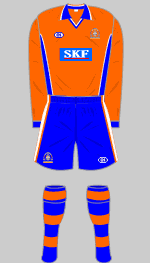
1999-2000 f n o
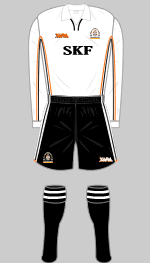
2001-2003 f
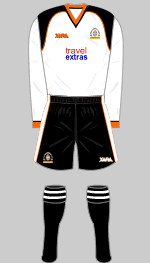
2003-2005 f
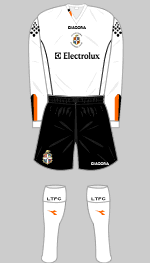
2005-2007 i t
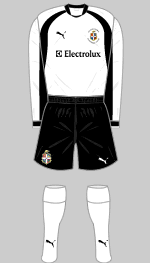
2007-2008 i q
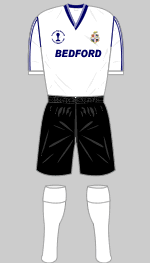
August 2008 l
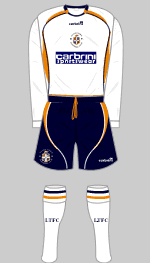
Aug 2008-2009 l
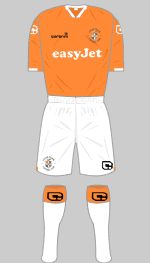
2009-2011 i
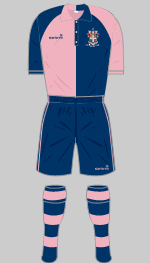
2010 Special i l
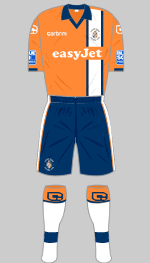
2011-2013 i
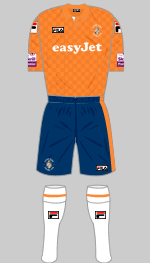
2013-2014 i
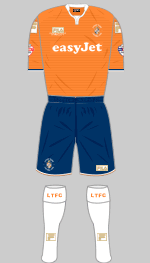
2014-2015 i
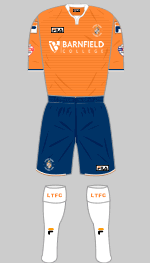
2015-2016 i
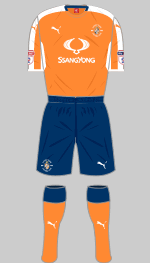
2016-2018 i
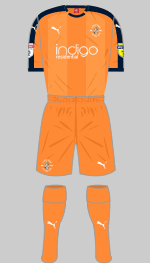
2018-2019 i
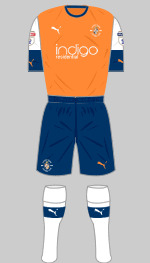
2019-2020 i
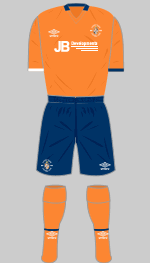
2020-2021 i
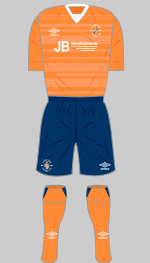
2021-2022 l
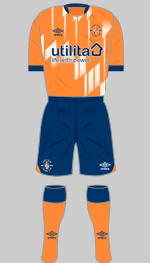
2022-2023 i
Background
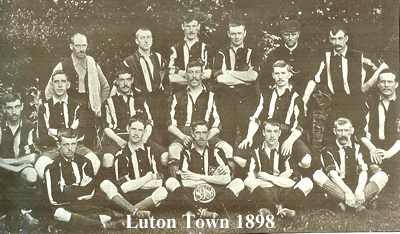
In 1880 Luton Wanderers and Luton Excelsior were formed and, along with the team from St John's College, established themselves as the leading sides in the town. Results against teams from London and elsewhere were, however, disappointing leading to some calls to create a single, combined team.
On 13 January 1885 a general meeting of the Wanderers' membership was held at which it was unanimously agreed to change the name of the club to Luton Town FC. The club secretary, Herbert Spratley would later argue that this meeting had been open to the public and meant that the former Wanderers were now defacto the representative team of Luton. This was later exposed as a lie.
On April 11 1885 a public meeting was held to consider the formation of a single team to represent the town to be called Luton Town Football Club. The motion was proposed and seconded but before the vote could be held, Spratley arrived and, after some rancourous discussion, proposed an amendment that "as there is already a Town Club in existence, it is not necessary to form a second club." This was overwhelmingly defeated and the original proposal was carried almost unanimously. It was further resolved that their first playing kit would be "navy blue and pink for both shirts and caps." There are no contemporary records about how these were arranged but a newspaper item from 1926 states the shirts were halved.
In October 1886 the club minute book, researched by Brian Webb, records that the club was to "obtain a guernsey (heavy woollen garment with a crew neck traditionally in navy blue) at 6s 6d from Spratley's." The minutes later record the purchase of a single "jersey" but there is no record of these being adopted by the team.
In August 1889 the committee decided on a change of colours and samples in "dark cardinal, self colour" were examined and the following month, 18 flannel shirts were delivered at a cost of £5 8s 0d. Local newspapers dubbed the team "The Reds." Luton were the first southern club to turn professional, which allowed the club to provide kit: amateur clubs were forbidden to do this and their players had to buy their own equipment.
Although the committee considered buying a set of white shirts in December 1891 the decision was postponed and in March 1892 players wore a "white band" to distinguish them from the visiting Edmonton side who wore similar shirts. Colours clashed again when Spurs visited three weeks later and this time some Luton players wore white shirts while others played in cardinal red. White alternative shirts were finally 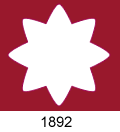 purchased in November to avoid future clashes.
purchased in November to avoid future clashes.
Webb has discovered from the minute books that in August 1892 the committee authorised a payment of £3 0s 0d to Bury Park FC for the purchase of their caps, shirts and goals. The Luton News reported in September that "The shirts now used are more of a claret than a red (sic)". Photographs reveal that a curious eight-pointed star adorned these new tops.
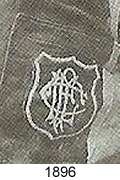 Distinctive shirts with white, black and cardinal stripes were adopted in 1896 and many were adorned with a crest featuring an elaborate monogram. The team are wearing these striped tops in a photograph taken prior to the 1898-99 season (above) but the Bedford Advertiser (Friday September 16th 1898) reported, "Luton are expected to wear their new shirts on Monday: the design is a pretty one of black and white and white knickers, Notts County offering closest resemblance." Their match
Distinctive shirts with white, black and cardinal stripes were adopted in 1896 and many were adorned with a crest featuring an elaborate monogram. The team are wearing these striped tops in a photograph taken prior to the 1898-99 season (above) but the Bedford Advertiser (Friday September 16th 1898) reported, "Luton are expected to wear their new shirts on Monday: the design is a pretty one of black and white and white knickers, Notts County offering closest resemblance." Their match 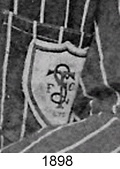 report the following Monday confirms, "The new black and white striped shirts gave a business like appearance." The comparison with Notts County is misleading: photographs and Brian Webb's research into the club minute book reveal that the committee ordered "black with small white striped shirts and white knickers." A badge was worn on these tops with the letters LTD included to mark the club becoming a limited company.
report the following Monday confirms, "The new black and white striped shirts gave a business like appearance." The comparison with Notts County is misleading: photographs and Brian Webb's research into the club minute book reveal that the committee ordered "black with small white striped shirts and white knickers." A badge was worn on these tops with the letters LTD included to mark the club becoming a limited company.
A team photograph taken before the 1899-1900 season shows the novel pin striped shirts but these were replaced in October by plain navy tops. The pinstripes continued to be worn by the reserves.
In 1897 Luton had been elected to the Second Division of the Football League at the expense of Burton Wanderers. At the time the majority of members were in the north and midlands and Luton struggled to meet their travel costs. After only three seasons, having finished in 17th place, they resigned rather than face re-election and rejoined the Southern League, adopting light blue and white as their new colours.
In 1920 Luton were readmitted to the Football League when the Southern League
First Division was incorporated as Division Three. At the time their first
choice of colours was still light blue with a change kit of black and
white 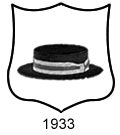 stripes. A directive from the Football League required teams to
travel with a set of white shirts in addition so, rather than carry the
costs of having three sets of kit, Luton adopted plain white shirts as
their first choice.
stripes. A directive from the Football League required teams to
travel with a set of white shirts in addition so, rather than carry the
costs of having three sets of kit, Luton adopted plain white shirts as
their first choice.
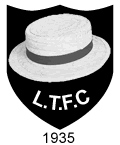 Luton was famous for producing
straw boaters, giving rise to the club's nickname of "The Hatters" (originally, the "Straw Plaiters"). This inspired the new crest, introduced in 1933: this was modified for the rather unusual shirts worn in 1935-36 and a third version appeared between 1936 and 1947. After finishing as runners-up in
1936 Luton
won the championship of Division Three (South) in 1937. (The graphics here are mock-ups as original images have yet to be found).
Luton was famous for producing
straw boaters, giving rise to the club's nickname of "The Hatters" (originally, the "Straw Plaiters"). This inspired the new crest, introduced in 1933: this was modified for the rather unusual shirts worn in 1935-36 and a third version appeared between 1936 and 1947. After finishing as runners-up in
1936 Luton
won the championship of Division Three (South) in 1937. (The graphics here are mock-ups as original images have yet to be found).
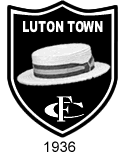 After the Second World War the Hatter crest was retired and instead the club adopted a simplified version of the Luton coat of arms although this did not appear on the team's shirts until the 1959 FA Cup final. Luton consolidated in Division Two
and thanks to a progressive youth policy, built a side that pushed for
promotion in
After the Second World War the Hatter crest was retired and instead the club adopted a simplified version of the Luton coat of arms although this did not appear on the team's shirts until the 1959 FA Cup final. Luton consolidated in Division Two
and thanks to a progressive youth policy, built a side that pushed for
promotion in 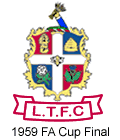 1953 and 1954 before a tight race in 1955 saw them finish
as runners-up for a place in Division One. Having finished eighth in 1958,
Luton reached the FA Cup final in 1959 where they lost to a Nottingham
Forest side reduced to ten men.
1953 and 1954 before a tight race in 1955 saw them finish
as runners-up for a place in Division One. Having finished eighth in 1958,
Luton reached the FA Cup final in 1959 where they lost to a Nottingham
Forest side reduced to ten men.
The decline that followed was dramatic and saw Luton plunge all the way down to the Fourth Division by 1965.
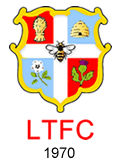 Faced with an indifferent public and with no money to invest in new players,
the future seemed bleak but their canny manager, Allan Brown, used free
transfers to bolster the team and in 1968 they won the Fourth Division
title and began a long climb back to the top. New money was brought in
when Reggie Burr and Tony Hunt, owners of the giant insurance company
Vehicle & General joined the board. Brown was controversially sacked
after applying for another management job and was replaced by Alec Stock
who guided the club back to Division Two in 1970. The Luton coat of arms made a brief appearance in the 1970-71 season.
Faced with an indifferent public and with no money to invest in new players,
the future seemed bleak but their canny manager, Allan Brown, used free
transfers to bolster the team and in 1968 they won the Fourth Division
title and began a long climb back to the top. New money was brought in
when Reggie Burr and Tony Hunt, owners of the giant insurance company
Vehicle & General joined the board. Brown was controversially sacked
after applying for another management job and was replaced by Alec Stock
who guided the club back to Division Two in 1970. The Luton coat of arms made a brief appearance in the 1970-71 season.
The money dried up when Vehicle & General collapsed in March 1970
and suddenly the club was forced to sell 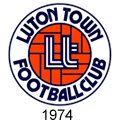 players to balance the books.
Among those released was Malcolm MacDonald, sold for what was then the
huge sum of £180,000 to Newcastle.
players to balance the books.
Among those released was Malcolm MacDonald, sold for what was then the
huge sum of £180,000 to Newcastle.
In February 1973 an unusual change strip was introduced that featured an orange shirt with a single black and white stripe down the left hand side and black collars and cuffs. This seemed to have been a success so the following season it was adopted as the team's first choice kit but with navy replacing the black. The two shirts are difficult to distinguish even in colour photographs but the 1973 version had a larger V inset at the colour.
Wearing their new colours, Luton won promotion to Division One in 1974. A modern crest was designed in 1973 but did not appear on the pitch until 1974-75. Over time the shirts would return to be predominantly white but the orange motif remains.
Many considered that promotion had come too quickly and that the club lacked the resources to remain at the top. They were proved right and the Hatters were relegated the following season. In 1978 David Pleat, the reserve team coach, was appointed manager and he set about building an attacking side that, in 1982 won the Second Division title with considerable flair. Goals flew in at both ends as Luton took on the First Division and only a last minute winner at Manchester City in the final game of the 1982-83 season saved them from relegation. The pictures of an ecstatic Pleat skipping around Maine Road in his naff suit remain one of the enduring images of the period.
Over the next few years, Luton consolidated and were among the first
clubs to install an artificial playing surface in 1985. These proved unpopular
and grass was restored to Kenilworth Road in 1991. Also controversial
was the decision to ban away supporters from Luton’s home matches.
Amid considerable acrimony, Pleat left in 1986 to manage Spurs. His replacement,
John Moore, who had played for Luton in the Fourth Division, took the
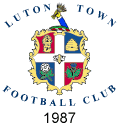 team to seventh place in 1987, their highest ever position, but he resigned
at the end of the season because he disliked holding such a high profile
job.
team to seventh place in 1987, their highest ever position, but he resigned
at the end of the season because he disliked holding such a high profile
job.
The traditional crest was reinstated in 1987 embellished with the club's name in full.
In April 1988, after the team had been beaten in the FA Cup semi-final,
an army of supporters made the short trip to Wembley to witness a dramatic
Littlewood’s League Cup final against Arsenal. Having trailed 1-2,
the Luton keeper saved a penalty and the team stormed back to win 3-2.
Luton had won their first major trophy. They reached the final again the
following season but their run of success was coming to an end and in
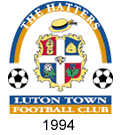 1992 they were relegated.
1992 they were relegated.
In 1994 the crest was redesigned and became known as "the rainbow badge" for obvious reasons. A straw hat replaced the extended arm at the top of the shield and the traditional nickname was added.
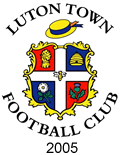 In 1999 the club returned to their traditional white shirts and black
shorts (albeit with orange trim) but was once again in long term decline
and by 2001 they had dropped all the way down to Nationwide Division Three
(the old Fourth Division). Remarkably, history appeared to be repeating
itself as the Hatters clambered their way back up and in 2005 they had
In 1999 the club returned to their traditional white shirts and black
shorts (albeit with orange trim) but was once again in long term decline
and by 2001 they had dropped all the way down to Nationwide Division Three
(the old Fourth Division). Remarkably, history appeared to be repeating
itself as the Hatters clambered their way back up and in 2005 they had 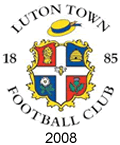 reached
The Championship (originally Division Two).
reached
The Championship (originally Division Two).
To mark this achievement a simplified crest was introduced with black rather than navy lettering. This was updated later to include the year of Luton's formation.
Unfortunately, Luton went into free fall and in 2008 they were relegated to League Two, the lowest level of the Football League, going into administration that spring. The club's difficulties were compounded during the close season: they were penalised 20 points for failing to reach a CVA (Company Voluntary Agreement) with their creditors as required by Football League regulations. A further ten points were deducted when they were found guilty by the FA of breaking the rules on payments to players' agents. Because of the uncertainty over their future, they did not negotiate a kit deal until August and started the season wearing retro shirts commemorating their 1988 Littlewood's Cup win.
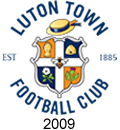 A poll of supporters led to a return to the white, navy and orange colour palette associated with happier times and the crest was slightly modified with a new font while orange and navy now featured in the central shield. The team were unable to overcome the severe disadvantage of a 30 point penalty.
A poll of supporters led to a return to the white, navy and orange colour palette associated with happier times and the crest was slightly modified with a new font while orange and navy now featured in the central shield. The team were unable to overcome the severe disadvantage of a 30 point penalty.
Inevitably the Hatters were relegated to the Conference in 2009 but supporters took consolation from a victorious trip to Wembley to win the Johnstone's Paint Trophy. The debacle raised serious questions over the Football League's policy of penalising clubs for breaching financial rules when those responsible for the infractions had already left 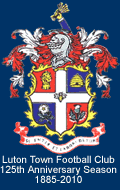 (taking considerable profits with them), leaving the new board and the supporters to suffer the consequences.
(taking considerable profits with them), leaving the new board and the supporters to suffer the consequences.
To mark what supporters and management alike hope would be a fresh start, Luton switched to orange shirts and white shorts for their first season in the Blue Square Conference while white shirts and navy shorts were retained as a change strip.
To mark their 125th anniversary, the club commissioned a special edition kit based on their original colours: this was worn three times, against Great Marlow in July 2010 in a replay of their first ever match, against Altrincham in the opening match of the season and against Bath City at the end of October. The shirts featured a special commemorative badge consisting of the town's coat of arms rendered in full for the first 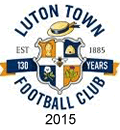 time.
time.
The retro theme was maintained in 2011 with the re-creation of Luton's iconic late-Seventies outfit.
After an absence of five seasons, Luton won the Conference and returned to the Football League. Supporters were canvassed on the colours to be worn in the 2014-15 season and the decision was to stick with orange, navy and white. As the 2015-16 season marked their 130th anniversary, another slight modification was made to the crest.
Winning the League One championship in 2019 lifted The Hatters into the second tier once more and in 2021-22 they reached the promotion play-offs.
Sources
- (a) Luton Town Fan Site
- (b) Brian Ellis
- (c) Football Focus
- (d) Doncaster Rovers FC - Images of Sport (Peter Tuffrey)
- (e) Classic Kits
- (f) empics
- (g) Bristol Rovers FC - Images of Sport (Mike Jay)
- (h) Football Cards
- (i) Luton Town Official Website
- (j) Sporting Heroes
- (k) Will Kelly
- (l) Simon Monks (HFK Research Associate)
- (m) The Luton Town Story 1985 - information provided by Simon Monks
- (n) David King
- (o) Simon Darnell
- (p) Football League Review provided by Simon Monks
- (q) Football Shirt Culture
- (r) Alick Milne
- (s) Christopher Worrall
- (t) Mark Hughesdon
- (u) Tim Davis
- (v) Keith Ellis (HFK Research Associate)
- (w) Shane Malia
- (x) The Straw Plaiters - Brian Webb's website devoted to Luton Town in the Victorian period.
- (y) Grandad's Football Blog
- (z) Tony Sealey
- (A) Football Past
- (B) Luton Town Football Club - The Full Record (Roger Wash & Simon Pitts 2014)
- (C) Charles Alcock's Football Annuals 1869-1891 researched by Robin Horton
Crests are the property of Luton Town FC. My thanks to Matthew Reynolds for crest information 2005-15.
